Automotive filters block contaminants that can damage the engine, transmission and fuel system. Many late model vehicles also have filters that protect the vehicle’s occupants from dust, pollen, odors and air pollution. Although today’s vehicles require much less maintenance then they used to, filters are still an important maintenance item. They need to be checked regularly, and replaced on an “as-needed” basis, or replaced at specific time or mileage intervals for preventive maintenance.
AIR FILTERS
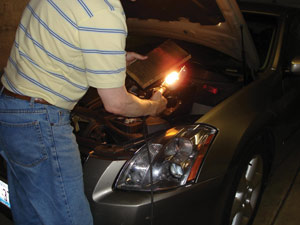 Every engine is equipped with an air filter to keep out dirt. An engine sucks in a lot of air when it is running: about 10,000 to 12,000 gallons of air for every gallon of fuel it burns! Consequently, the air filter has to have a large surface area and plenty of filtering capacity to trap and hold all of the contaminants that may be present in the air.
Every engine is equipped with an air filter to keep out dirt. An engine sucks in a lot of air when it is running: about 10,000 to 12,000 gallons of air for every gallon of fuel it burns! Consequently, the air filter has to have a large surface area and plenty of filtering capacity to trap and hold all of the contaminants that may be present in the air.
One of the most common ingredients in airborne dirt is silica, a hard abrasive mineral that’s found in sand and clay. If silica gets inside the engine, it has the same effect as sandpaper. It scours the piston rings, cylinders, valves and bearings, and causes the engine to wear rapidly.
Air filters remove dirt by trapping contaminants as the air flows through the filter media. The percentage of particles removed is a measure of the filter’s efficiency. A good quality air filter generally traps upwards of 98.5 percent of the incoming dirt. Filter manufacturers use SAE J726 test procedures to evaluate their air filters, and try to aim for the best balance between filtering efficiency, filter capacity and pressure drop (restriction). Cheap low-quality filters are typically less efficient and may not have as much holding capacity as a quality brand name filter.
Filter efficiency depends on the type of media used. Most of today’s dry paper pleated element air filters are made of a mixture of cellulose and synthetic fibers. The higher the percentage of synthetic fibers, generally speaking, the better the filter.
Better-quality paper filters are also treated with resins so they can withstand moisture. Untreated paper filters may be damaged if rain enters the air filter housing.
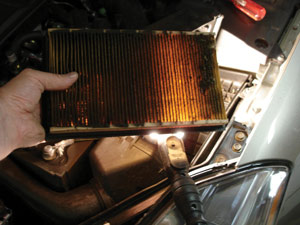 As dirt builds up in on the surface and in the fibers of an air filter, it begins to restrict airflow through the filter. Eventually, the point is reached where the increasing restriction begins to affect engine performance, choking the incoming air supply. Ideally, filters should be replaced before they become too restrictive. This requires inspecting the filter and replacing the filter if it is obviously clogged with debris — but also replacing the filter after so many miles (typically 15,000 to 30,000) regardless of its outward appearance. Why? Because it’s often hard to see how much dirt has become embedded within the filter fibers.
As dirt builds up in on the surface and in the fibers of an air filter, it begins to restrict airflow through the filter. Eventually, the point is reached where the increasing restriction begins to affect engine performance, choking the incoming air supply. Ideally, filters should be replaced before they become too restrictive. This requires inspecting the filter and replacing the filter if it is obviously clogged with debris — but also replacing the filter after so many miles (typically 15,000 to 30,000) regardless of its outward appearance. Why? Because it’s often hard to see how much dirt has become embedded within the filter fibers.
Most experts recommend inspecting the air filter every time the oil is changed (every three to six months), and replacing it yearly or every 15,000 miles for preventive maintenance. Most vehicle manufacturers say to inspect the filter at 15,000 miles and to replace it at 30,000 miles in their scheduled maintenance recommendations.
Replacing a dirty air filter can improve fuel economy, performance and emissions. It’s hard to say how much of a difference a new filter will make because the improvement depends on how dirty the old filter was before it was changed.
Many people don’t know how to inspect a flat panel air filter. If they just open the top of the filter housing and peer inside, the filter may look good as new. That’s because they are looking at the “clean” side of the filter that is downstream of the air inlet. The bottom side of the flat panel filter is the dirty side that is often caked with dirt, debris and dead bugs.
The right way to inspect a panel air filter, or a round air filter in an older vehicle, is to remove the filter from its housing and hold a shop light behind it. A little discoloration is normal, but if the filter is dark and blocks the light, it is overdue for a change.
Some people think all they have to do is bang the filter on the ground to knock loose the dirt, or blow it from the inside out with compressed air to clean it. This will dislodge some of the surface dirt, but it will not remove any of the microscopic particles that are embedded in the filter media.
When replacing a filter, it’s a good idea to compare the old and new filters to make sure are are the same size and thickness. A filter that does not fit the air cleaner housing properly will leak and allow unfiltered air to be sucked into the engine.
Close attention also needs to be paid to the filter housing. Some plastic housings can become distorted as a result of heat exposure, causing them to leak.
On some later model Ford Duramax diesel pickup trucks, a new type of “axial flow” conical air filter is used. The filter uses a corrugated media that forces the air to flow lengthwise through the honeycomb channels before it turns 90 degrees and passes through the filter media. The filter provides a lot of surface area, but is a patented design — which means expensive if a customer has to buy it from a new car dealer. Fortunately, several aftermarket filter manufacturers now offer replacement alternatives for these pricey filters, including a retrofit filter kit that allows the OEM round axial flow filter to be replaced with a standard flat panel filter.
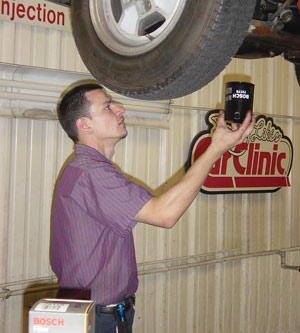 What about “washable” performance air filters? These low-restriction filters typically use a cotton filter media that is impregnated with light oil. The oil causes dirt particles to stick to the media. When the filter becomes dirty, it can be removed, washed in warm soapy water, reoiled and reused. These filters can often go 30,000 to 50,000 miles before they have to be removed and washed. There is one precaution, however. If too much oil is applied to the filter, some of the oil may be be pulled into the engine and contaminate the mass airflow sensor element (which may result in lean codes and engine performance problems).
What about “washable” performance air filters? These low-restriction filters typically use a cotton filter media that is impregnated with light oil. The oil causes dirt particles to stick to the media. When the filter becomes dirty, it can be removed, washed in warm soapy water, reoiled and reused. These filters can often go 30,000 to 50,000 miles before they have to be removed and washed. There is one precaution, however. If too much oil is applied to the filter, some of the oil may be be pulled into the engine and contaminate the mass airflow sensor element (which may result in lean codes and engine performance problems).
Some paper air filters are also being pre-oiled by the filter manufacturer so the filter will trap and hold more dirt. These type of filters are NOT reusable and should be replaced once they become dirty.
CABIN AIR FILTERS
Cabin air filters are now used in most late model vehicles. They first appeared appeared back in the mid-1980s on Audi and other European makes. Today, about 80 percent of all new import and domestic vehicles have a cabin air filter, or a slot where one can be installed if one was not installed at the factory.
The cabin air filter is primarily for the benefits of the vehicle’s occupants because it keeps dust and pollen out of the car. If the filter also has a layer of activated charcoal and/or baking soda, it will also stop odors and pollutants — but only for a year or so. After that, the odor-absorbing ingredients become depleted and the filter needs to be replaced. Filters that stop dust only typically have a lifespan of 20,000 to 30,000 miles depending on operating conditions.
Many motorists are not aware their vehicle has a cabin air filter, or that it needs to be inspected and replaced. Consequently, customer education is a major challenge when it comes to selling cabin air filters.
One way to tell if a vehicle has a cabin air filter is to check the vehicle owner’s manual. You can also check your catalog listings or vehicle data base to see if a cabin air filter is shown for the vehicle.
Replacing a cabin air filter is relatively easy on many vehicles, but can take up to 45 minutes or more on some applications. The filter is usually located behind the glove box (which may require removing the glove box door or liner, or it is located at the base of the windshield (open the hood and look in the cowl area for a small access door).
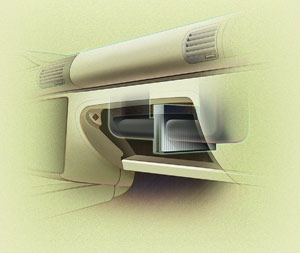 If a cabin air filter is ignored, it can become a breeding ground for mold and bacteria. This can contribute to unpleasant odors from the A/C system as well as create a potentially unhealthy situation for the vehicle’s occupants. An upgrade opportunity here is to replace an ordinary dust-only cabin air filter with one that has odor-absorbing media and is treated to resist mold, mildew and bacteria.
If a cabin air filter is ignored, it can become a breeding ground for mold and bacteria. This can contribute to unpleasant odors from the A/C system as well as create a potentially unhealthy situation for the vehicle’s occupants. An upgrade opportunity here is to replace an ordinary dust-only cabin air filter with one that has odor-absorbing media and is treated to resist mold, mildew and bacteria.
A plugged cabin air filter can also restrict airflow through the HVAC system, reducing airflow to the air conditioner, defrosters and heater.
OIL FILTERS
Most vehicle manufacturers have been promoting longer oil and oil filter change intervals, or are now using oil reminder lights to alert the driver when it’s time to change the oil. Under ideal operating conditions, some oil reminder lights many not come on until 7,500 to as much as 12,000 miles! Cadillac recommends 7,500-mile oil change intervals on the 2006 and up XLR, as does Nissan for the Altima. Chrysler has stretched the oil change intervals to 6,000 miles on its 300 models. Ford recommends 5,000-mile intervals on the F-150 truck, Taurus and Mustang. Toyota is also at 5,000 miles for the Camry. Just keep in mind that all of these are for “normal” service (which means ideal driving conditions). Many vehicles actually fall into the “severe service” category because they are used for short trip, stop-and-go commuting.
For severe service, most OEM’s still recommend changing the oil and filter every 3,000 miles (though Nissan says 3,750 miles is okay).
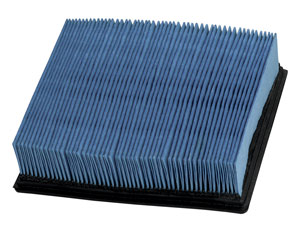 Regardless of the interval, it’s important to always replace the oil filter when the oil is changed. The small size of many oil filters today do not have much reserve capacity for extended service intervals — though extended life replacement filters are available as an upgrade over a standard replacement filter.
Regardless of the interval, it’s important to always replace the oil filter when the oil is changed. The small size of many oil filters today do not have much reserve capacity for extended service intervals — though extended life replacement filters are available as an upgrade over a standard replacement filter.
Like air filters, most quality oil filters use a mixture of cellulose and synthetic fibers in the filter media. The higher the percentage of synthetic fiber, the more efficient the filter.
Here’s a little-known fact about oil filters: when a cold engine is first started, most of the oil bypasses the filter until the oil hits about 100 degrees F. That’s because cold oil is very thick and does not pass through the filter media easily.
A growing number of late model vehicles have gone away from the traditional spin-on oil filter, and are now using a cartridge style filter. Both types have the same filtering efficiency and capacity, but the cartridge filters are considered to be more environmentally-friendly because there is no metal shell. Because of this, the filters can be disposed of by incineration rather than being buried in a landfill. Applications include most late model European cars, as well as some Japanese cars and a few domestic models (such as Ford Fusion).
Changing one of these new cartridge style filters can be tricky because there is usually a rubber O-ring on the filter housing or top. The O-ring should also be replaced, and it must be properly positioned otherwise it can leak.
Spin-on filters are also changing, too. The threaded hole in the base of the filter is usually a larger diameter than it used to be so the filter can flow more oil. Many engines now have 22mm threads on the filter fitting.
Another innovation that’s available in some spin-on filters are time-release additives that help extend the life of the oil. These are a good alternative for older engines that may have a lot of wear and blowby.
FUEL FILTERS
The replacement market for fuel filters has changed dramatically in recent years. Many late model vehicles now have “lifetime” fuel filters that are part of the fuel pump assembly inside the fuel tank. Consequently, there is no recommended replacement interval for these — and the filters are usually not even available as a separate item anyway. If the filter plugs up, the customer has to buy a whole new fuel pump assembly!
On vehicles that do have in-line fuel filters, the recommended replacement interval for preventive maintenance typically ranges from 30,000 to 50,000 miles.
A plugged fuel filter will restrict fuel flow to the engine. The drop in pressure may not be noticeable at idle, but as engine speed goes up, there can be a measurable drop in pressure. Symptoms include a loss of high-speed power, lean misfire, hesitation and even hard starting.
A new fuel filter should always be installed if a fuel pump is being replaced. If a new filter becomes clogged shortly after it has been installed, the inside of the fuel tank is probably dirty or rusty.
TRANSMISSION FILTERS
Most vehicles do not have an OEM recommended service interval for the transmission filter, but some do. On a 2006 Ford F-150 truck with an automatic, for example, Ford recommends replacing the transmission filter at 30,000 miles.
The reason why transmission filters have a long service life is because the fluid is not subjected to engine blowby like motor oil. Consequently, the fluid doesn’t become contaminated with moisture and acids like motor oil does (which can cause engine-damaging sludge to form). Heat is the main enemy of transmission fluid, and if the fluid gets too hot, it can oxidize and break down. The filter should be replaced when the fluid is changed.












